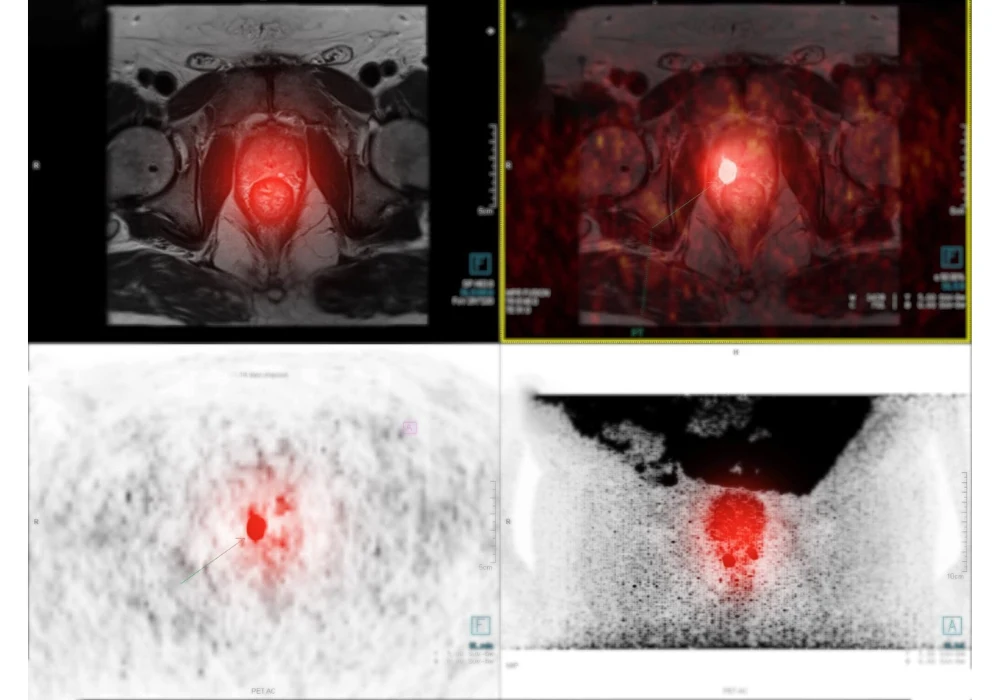Advanced prostate cancer (APC), encompassing stages such as metastatic hormone-sensitive prostate cancer (mHSPC) and castration-resistant prostate cancer (mCRPC), presents complex challenges for diagnosis and treatment. Traditional imaging methods, including CT and bone scans, have been widely used to assess metastatic disease, but their limitations in accuracy often affect treatment planning. The introduction of advanced imaging technologies, particularly prostate-specific membrane antigen positron emission tomography (PSMA-PET/CT) and whole-body magnetic resonance imaging (WB-MRI), offers new possibilities for enhancing diagnostic precision. These methods promise to improve disease detection, characterization and treatment management, potentially transforming patient outcomes.
Disease Detection and Staging
PSMA-PET/CT stands out for its ability to accurately detect metastatic disease in APC patients. Compared to conventional imaging techniques, PSMA-PET/CT demonstrates superior sensitivity and specificity, particularly in identifying nodal and distant metastases. The technology's high resolution allows for the detection of micrometastases, which may be missed by traditional methods, enabling more precise staging. This, in turn, facilitates early intervention and tailored treatment strategies that could improve prognosis.
Recommended Read: PSMA PET/CT Strengthens Primary Prostate Cancer Staging
WB-MRI also plays a critical role in detecting metastatic disease, particularly bone metastases. Its high sensitivity allows it to outperform conventional bone scans and CT, especially in patients with bone-only metastases. By identifying high-risk, bone-only metastatic disease, WB-MRI enhances risk stratification and aids in personalising treatment plans. Together, PSMA-PET/CT and WB-MRI provide complementary advantages in detecting and staging advanced prostate cancer, making them indispensable tools in modern diagnostic oncology.
Disease Characterisation and Aggressiveness Assessment
Accurate disease characterisation is crucial for determining appropriate treatment strategies, as aggressive variants of prostate cancer often require more intensive interventions. PSMA-PET/CT offers valuable insight into disease aggressiveness by providing functional and metabolic information about metastatic lesions. Higher standardised uptake values (SUVmax) on PSMA-PET scans are associated with more aggressive disease and poorer clinical outcomes. By assessing tumour heterogeneity, PSMA-PET/CT can help clinicians understand the underlying biology of the disease, guiding decisions regarding treatment intensity and patient management.
Similarly, WB-MRI contributes to characterising the aggressiveness of prostate cancer, particularly through multiparametric imaging techniques. Diffusion-weighted imaging (DWI) and apparent diffusion coefficient (ADC) values on WB-MRI allow for the assessment of tumour cellularity and bone marrow involvement, which are indicative of disease progression and aggressiveness. These imaging biomarkers provide essential prognostic information that can inform treatment decisions, particularly when conventional methods fail to offer sufficient detail. The combined use of PSMA-PET/CT and WB-MRI allows for a more comprehensive evaluation of disease aggressiveness, offering clinicians a better understanding of tumour behaviour.
Impact on Treatment Management
One of the key advantages of high-accuracy imaging techniques like PSMA-PET/CT and WB-MRI is their ability to influence treatment planning, especially in the context of metastasis-directed therapy (MDT). In patients with oligometastatic disease, where the number of metastatic sites is limited, these imaging methods allow for the precise identification of small, previously undetected lesions. This enables the use of highly focused therapies such as stereotactic body radiation therapy (SBRT), which targets specific metastatic sites while minimising damage to surrounding healthy tissues. Studies have shown that MDT, when guided by PSMA-PET/CT and WB-MRI, can significantly improve disease-free survival and overall survival, particularly for patients with low-volume bone disease.
Furthermore, PSMA-PET/CT plays a pivotal role in refining radiotherapy planning. Its ability to accurately identify metastatic sites allows for more precise target identification and dose escalation, optimising the effectiveness of radiotherapy while reducing the risk of collateral damage to healthy tissues. This precision makes PSMA-PET/CT invaluable in the planning of both initial treatment and salvage therapies, ensuring that patients receive the most appropriate care based on their specific disease characteristics. By enhancing the accuracy of radiotherapy planning, PSMA-PET/CT contributes to improved treatment outcomes in APC patients.
In addition to guiding radiation therapy, PSMA-PET/CT is essential in selecting patients for PSMA-targeted radioligand therapy (RLT), a promising treatment for metastatic prostate cancer. By identifying PSMA-positive lesions, PSMA-PET/CT helps clinicians determine which patients are likely to benefit from RLT, enabling a more personalised approach to treatment. This targeted therapy has shown significant promise in improving patient outcomes, especially in cases where conventional treatments have been ineffective. As the role of PSMA-targeted therapies expands, the use of PSMA-PET/CT in patient selection will become increasingly important.
The integration of PSMA-PET/CT and WB-MRI into the management of advanced prostate cancer offers significant advantages in terms of disease detection, characterization and treatment planning. These imaging techniques provide a level of precision that traditional methods cannot match, allowing for earlier detection of metastases, better staging and a more accurate assessment of disease aggressiveness. As a result, they enable more personalised treatment strategies, improving patient outcomes. While the potential of these imaging modalities is clear, further prospective clinical trials are necessary to confirm their long-term impact on survival and quality of life. Nonetheless, PSMA-PET/CT and WB-MRI are poised to play a central role in the future of prostate cancer management, helping to usher in an era of more targeted and effective treatments.
Source: European Radiology
Image Credit: iStock






